I’m thrilled to sit down with Dominic Jainy, an IT professional whose deep expertise in artificial intelligence, machine learning, and blockchain has positioned him as a thought leader in the tech world. With a passion for applying cutting-edge technologies across industries, Dominic brings a unique perspective to the evolving landscape of AI. Today, we’re diving into his insights on a pioneering startup called Humans&, which is making waves with its mission to train AI models for human collaboration rather than replacement. We’ll explore the innovative approaches behind their technology, the challenges of building such ambitious systems, and the vision driving this frontier lab.
How did you first become involved with a project like Humans&, and what excites you most about its mission?
I’ve always been fascinated by the intersection of technology and human potential. When I came across Humans&, I was immediately drawn to their focus on building AI that works alongside people, enhancing our capabilities rather than automating us out of the picture. What excites me most is their vision of creating systems that truly understand individual preferences and values, making technology a partner in solving real human problems.
What do you think sets Humans& apart from other AI labs that prioritize automation over collaboration?
Humans& is taking a fundamentally different path. While many labs are racing to build fully autonomous systems, Humans& is asking how AI can empower people by adapting to their unique needs and goals. It’s about creating a synergy where AI doesn’t just perform tasks but actually understands context and human nuances, which I believe is critical for meaningful progress.
Can you walk us through the core idea of training AI models to remember and react to personal preferences, and why this matters?
At its heart, this approach is about personalization on a deep level. The idea is to train models that don’t just process data but retain and adapt to an individual’s interests, ambitions, and even weaknesses over time. This matters because it shifts AI from being a one-size-fits-all tool to something that feels like a tailored assistant, capable of helping each person in a way that’s uniquely relevant to them.
Why do you believe collaboration between AI and humans is so essential for tackling major challenges?
Collaboration is key because humans and machines each bring something unique to the table. Humans have creativity, emotional intelligence, and ethical judgment, while AI offers speed, scale, and data processing. By focusing on collaboration, we can combine these strengths to address complex issues—whether it’s in healthcare, education, or climate change—more effectively than either could alone.
Humans& has mentioned that their training methods require significantly more computing power. Can you explain why that is?
Absolutely. Training AI to understand and adapt to individual human behaviors and preferences involves processing massive amounts of diverse, dynamic data. Unlike traditional models that follow static patterns, this approach requires continuous learning and real-time adjustments, which demands a lot more computational resources to simulate those interactions at scale.
What are some of the biggest hurdles you foresee in developing this kind of collaborative AI technology?
One major hurdle is the sheer scale of resources needed—both in terms of computing power and funding. There’s also the challenge of ensuring the AI remains ethical and unbiased while learning from highly personalized data. Balancing privacy with personalization is tricky, and getting it wrong could erode trust. Finally, there’s the technical challenge of making these systems intuitive enough for everyday users without oversimplifying the underlying complexity.
With such a diverse founding team, how do you think their varied backgrounds contribute to the vision of Humans&?
The team’s diversity is a huge strength. You’ve got expertise ranging from language model reasoning to behavioral learning and large-scale system design. Each perspective adds a layer to the project—whether it’s understanding how humans think, building robust infrastructure, or innovating on how AI learns. This mix of skills ensures they’re not just solving technical problems but also addressing the human side of the equation.
There’s talk of a significant funding round for Humans&. From your perspective, how critical is this level of investment for their goals?
It’s absolutely critical. Developing frontier AI, especially with a novel training paradigm, is incredibly resource-intensive. This kind of funding allows them to secure the computing power, talent, and time needed to experiment and iterate without cutting corners. It’s a big bet, but for a mission as ambitious as theirs, it’s the kind of support that can make or break the project.
What’s your forecast for the future of collaborative AI, and how do you see initiatives like Humans& shaping that trajectory?
I’m optimistic that collaborative AI will become a cornerstone of how we interact with technology in the coming decade. Initiatives like Humans& are paving the way by proving that AI can be more than a tool—it can be a partner. If they succeed, I think we’ll see a shift in how industries and individuals adopt AI, moving toward systems that amplify human potential rather than replace it. Their work could redefine trust and utility in AI, setting a new standard for what’s possible.

